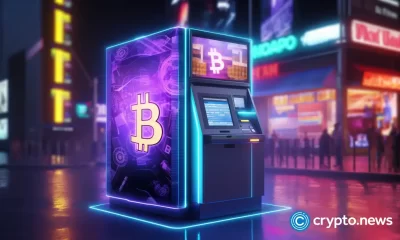C-Buzz
SEC proposes tougher rules as part of its crypto custody crackdown
Published
1 year agoon
By
admin
The new proffers set forth by the Gensler- led Securities and Exchange Commission seek to “ expand the compass ” of rules set out by the 2009 Custody Rules.
A five- member panel of the United States Securities Exchange Commission( SEC) has suggested 4- 1 in favor of an offer that may make it more delicate for cryptocurrency enterprises to serve as digital asset custodians in the future.
The offer, which is yet to be officially approved by the SEC, recommends amendments to the “ 2009 Custody Rule ” will apply to custodians of “ all means ” including cryptocurrencies, according to aFeb. 15 statement from SEC Chairman Gary Gensler.
Gensler stated that presently, some crypto trading platforms that are offering guardianship services aren’t factually “ good custodians. ”
According to the SEC, a good custodian is generally a civil or state- chartered bank or savings association, trust company, a registered broker- dealer, a registered futures commission trafficker or a foreign fiscal institution.
In order to come a “ good custodian ” under the recently proposed rules,U.S. and coastal enterprises would also need to insure that all custodied means including cryptocurrencies are duly insulated, while these custodians will be needed to jump through fresh loops similar as periodic checkups from public accountants, among other translucency measures.
While Gensler said these emendations would “ expand the compass ” to all asset classes, he specifically took a shot at the crypto assiduity
“ Make no mistake, moment’s rule, the 2009 rule, covers a significant quantum of crypto means.(.) Further, though some crypto trading and lending platforms may claim to guardianship investors ’ crypto, that doesn’t mean they’re good custodians. Rather than duly separating investors ’ crypto, these platforms have interfused those means with their own crypto or other investors ’ crypto. ”
“ When these platforms go void — commodities we ’ve seen time and again lately — investors ’ means frequently have come property of the failed company, leaving investors in line at the ruin court, ” the SEC president added.
Gensler also refocused to the assiduity’s track record to suggest that many crypto enterprises would be dependable enough to serve as good custodians
“ Make no mistake, Grounded upon how crypto platforms generally operate, investment counsels can not calculate on them as good custodians. ”
Still, not every SEC member is on board with Gensler’s plans.
While the offer is n’t “ regulation by enforcement ” per se, Commissioner Hester Peirce said “ the rearmost SEC statement seems designed for immediate effect ” to take down the crypto assiduity
“ Similar broad statements in a rule offer feel designed for immediate effect, a function proposing releases shouldn’t play. These statements encourage investment counsels to back down incontinently from advising their guests with respect to crypto. ”
As for the offer itself, Peirce believes it would do further detriment than good.
She said that similar strict measures will force investors to remove their means from realities that have developed sufficient securing procedures to alleviate and help fraud and theft
“ The offer would expand the reach of the guardianship conditions to crypto means while likely shrinking the species of good crypto custodians. By averring on an asset neutral approach to guardianship we could leave investors in crypto more vulnerable to theft or fraud, not lower. ”
As for the coming way, Peirce noted the agency will soon record in a 60- day comment period once the offer has been published in the Federal Register.
However, the manager is concerned that this timeframe is n’t sufficient to allow the public to dissect all aspects of the offer.
Those who suggested in favor of the offer stopgap to apply the new rules within 12 to 18 months, according to Peirce, who added that it was an “ aggressive timeline ” given the changes being proposed.
The post SEC proposes tougher rules as part of its crypto custody crackdown first appeared on BTC Wires.
Source link
You may like


Exclusive: Savl’s COO on new frontiers of KYC


Binance Warns Of Delisting These Tokens, Price Drop Ahead?


Top cryptocurrencies to watch this week: MOG, KAS, FET


CurveDAO (CRV) Nears All-Time Low Following Whale Deposit to Binance: On-Chain Data


Japanese Tech Giant Sony Enters Crypto Exchange Business With This Acquisition


Bitcoin ATM installations reach 38k, below the all-time high
C-Buzz
Successful Beta Service launch of SOMESING, ‘My Hand-Carry Studio Karaoke App’
Published
2 weeks agoon
June 15, 2024By
adminJun 15, 2024 13:26 UTC
| Updated:
Jun 15, 2024 at 13:26 UTC
By Raghav Sawhney
Solana has brought major retail to various memecoins through the launch of pump.fun. There are a few token-launches that have gone absolute Nuts!
Meme-coins are loosely defined as a genre of cryptocurrency where its creators promote it on social media platforms to create initial hype and drive up the price. Tokens of these memes are available to the general public and anyone who is enthusiastic about the coin is more than welcome to hold this fun asset type.
Let’s explore a few origin stories where Solana-based Meme-coin founders took “ready to do whatever it takes” too seriously:
SLERF
Imagine launching a meme coin and accidentally burning $10 million meant for early investors. That’s what happened with SLERF, a Solana-based meme coin, in March 2024.

SLERF, a sloth-themed token, surpassed all Ethereum-based exchanges in trading volume within a day. The developer’s mistake of burning over $10 million from the presale caused a frenzy, but the value of SLERF soared from 3 cents to $1.4. In its first 24 hours, SLERF’s trading volume hit $2.7 billion, with 800,000 trades from 130,000 traders, reaching a market cap of $650 million at its peak.

The Solana community and exchanges like HTX and Bitget rallied to support affected presale participants, raising over $450,000 in donations. This unexpected twist made SLERF a “blue-chip meme,” with its trading volume and market cap continuing to rise.
The disaster highlighted the project’s fairness: no presale allocation to dump on investors, and burnt LP tokens ensured it wasn’t a rug pull. SLERF turned an epic fail into a massive success, cementing its place in meme coin history.
DARE
The story of the Solana-based meme coin “Truth or Dare” (DARE) is as dramatic as it gets in the crypto world. Its creator, Mikol, took the idea of daring to an extreme level that ended disastrously.

“Truth or Dare” (DARE) gained notoriety in May 2024 due to an extreme promotional stunt by its developer, Mikol. During a livestream, Mikol doused himself in isopropyl alcohol and had fireworks directed at him, resulting in third-degree burns over 35% of his body. Despite the severity of his injuries, Mikol reassured his community from his hospital bed that he was recovering and committed to continuing the project.
DARE launched at a modest price of $0.000-1 and saw a dramatic increase in value following the incident, reaching a peak price of $0.0015, marking a 14000% increase. The token’s market cap at its peak was approximately $2,650,000. The stunt, although disastrous, ironically succeeded in boosting the DARE token’s popularity and investment interest.

The crypto community reacted with mixed feelings to the incident. While some praised Mikol’s dedication, others criticised the dangerous marketing tactics. The token’s value surged temporarily due to the increased attention, and Mikol’s community has shown support by contributing to his medical treatment and continuing to back the project
Mikol’s dangerous act highlights the risks associated with extreme marketing tactics in the crypto world. Despite the controversy, the DARE community has shown support by contributing towards Mikol’s medical treatment and continuing to back the project.
FADELIVE
The Solana-based meme coin “FADE” gained attention in May 2024 due to a promotional stunt that went awry. The creators organized a live-streamed boxing match between two fighters to promote their token, aiming to reach a $69,000 market cap and potentially get listed on the Solana DEX, Raydium. Unfortunately, during the event, one fighter lost a tooth, and the fight had to be paused for medical attention.

Despite the setback, the FADE token managed to hit a market cap of $30,000 during the event, and it gained a featured spot on Pump. The incident caused a temporary dip in the token’s value, but there is speculation about a rematch as the involved accounts remain active, though no official news has confirmed this yet.

Currently, FADE’s market cap has fluctuated, reflecting the volatile nature of meme coins. At its peak, FADE achieved a significant market cap increase, but it remains to be seen if the hype can be sustained in the long run. This incident highlights the lengths some developers will go to in promoting their tokens within the competitive meme coin space on Solana.
LIVEMOM
The LIVEMOM token became infamous due to a livestream stunt where a teenager and his mom promised to show her breasts if the token’s market cap reached $300,000.

The stunt quickly gained popularity, attracting over 1,500 viewers. As the market cap approached the target, the stream abruptly ended, with the son claiming battery issues. This caused the token’s market cap to plummet to around $120,000 within the next five minutes.

The duo shortly launched a new token, LIVEMOM2 on a fresh stream, but it quickly fell to zero, and all related social media accounts were deleted. Despite this, the original LIVEMOM token experienced a community-driven resurgence, with its market cap reaching $3 million at one point before stabilising around $1 million. The community has since taken over the project, creating a new website and maintaining active discussions
HANDS
The HANDS token story is a classic example of a rug pull gone viral for its audacity. The pseudonymous developer “NoHandsNoRug” streamed himself on Twitch, claiming he couldn’t rug pull the project because he had no hands, showing a piece of paper tucked under his chin to reinforce his claim.

However, just three minutes into the stream, he revealed his hands from behind his back and pulled all the liquidity from the project, ending the stream abruptly and leaving investors empty-handed! The developer made away with about 7 SOL, worth a little over $1,000 at the time.

Despite the initial rug pull, the HANDS token caught the attention of the crypto community. Within a day, four anonymous individuals initiated a ‘community takeover’, creating a new Twitter and Telegram account, and developing a website for the token. The token saw approximately $552,000 in trading volume, but its market cap dropped to around $16,000 shortly after the takeover

The community’s efforts to revive the token involved burning liquidity to prevent further rug pulls, although one anonymous trader still held about a third of the entire token supply, posing a potential risk for future manipulation.
LIVESIS
The LIVESIS token, a clone project of LIVEMOM, gained notoriety for its explicit promotional strategy. The creator promised that once the token’s market cap reached $100,000, his sister would take off her bra.
This stunt attracted significant attention and, upon reaching the target, the sister did go topless. However, many speculated that the sister was actually a man.

Following this reveal, the creator dumped his entire holding while playing “Pump it Up” in the background, causing the market cap to plummet rapidly. Although the initial stunt saw the token hitting its goal, the rug pull led to the market cap dropping to nearly zero shortly after.
Despite this, the token had moments of significant trading volume, with around $552,000 recorded. However, the market cap eventually stabilised at approximately $16,000, and the creator’s actions left many investors disappointed and empty-handed.

This article has been written taking inspiration from @starplatinumSOL ‘s thread on twitter.

Raghav Sawhney
Raghav is a significant contributer who uses his knowledge, skills and experience towards development & growth of the organisation in an efficient and effective manner.
Source link
account abstraction
Vitalik Buterin Suggests EIP-7702 to Enhance Account Abstraction on Ethereum
Published
3 weeks agoon
June 7, 2024By
admin
Ethereum might soon experience a significant enhancement with the introduction of EIP-7702. Proposed by co-founder Vitalik Buterin, this upgrade focuses on improving “account abstraction” on the blockchain platform.
- Vitalik Buterin and his co-authors introduced EIP-7702 as a substitute for EIP-3074 to improve the abstraction of accounts in Ethereum.
This proposal allows externally owned accounts (EOAs) to function as smart contract wallets temporarily during a transaction, then return to their initial state afterward.
What is EIP 7702 ?

EIP 7702 Aims to Improve Security and Compatibility
As per the Github summary, EIP 7702 stands out as a crucial alternative to the current EIP-3074, tackling major vulnerabilities by steering clear of opcodes that are expected to become obsolete and avoiding fragmentation within the ecosystem. It is designed to be forward-compatible with future quantum computing advancements and aims for seamless integration with EIP 4337, which is increasingly important as quantum technology progresses.
Authored by Vitalik Buterin, Sam Wilson, Ansgar Dietrichs, and Matt Garnett, the EIP presents a novel transaction type that temporarily transforms user accounts into smart contract wallets. This innovation enables complex operations, such as combining multiple actions into a single transaction, thereby boosting the network’s efficiency and flexibility.
EIP 7702 claims to streamline user interactions and lower transaction costs on decentralized exchange (DEX) platforms by removing the need for multiple transaction steps, representing a significant advancement over existing limitations. The community seems highly interested in this new proposal.
A key feature of EIP 7702 is its focus on enhancing user security and autonomy. According to the Github summary, it permits users to sign transactions with temporary, specific permissions, thereby minimizing risks related to key compromises. This aspect not only increases user trust in the system but also strengthens the Ethereum network’s capability to address both present and future security challenges effectively.
When Buterin and his co-authors presented their EIP, it garnered significant attention for its quantum resistance, addressing long-standing concerns in the cryptocurrency community about the threat of quantum computing. This proposal is seen as a proactive measure to mitigate potential quantum threats.
Key Improvements Introduced by EIP-7702
Enhanced Security
EIP-7702 eliminates the permanent delegation aspect seen in EIP-3074, reducing the risk of funds being stolen by malicious contracts.
Soft Fork Compatibility
Unlike EIP-3074, EIP-7702 can potentially be implemented via a soft fork, making it a less disruptive network upgrade.
Improved Compatibility
EIP-7702 is designed to be compatible with the ERC-4337 standard, promoting a more unified approach to account abstraction.
Quantum Resistance
EIP-7702 is regarded as more resistant to quantum computing threats than EIP-3074, offering better future-proof protection.
How EIP-7702 Achieves These Improvements
New Transaction Type
EIP-7702 introduces a new transaction type with fields for contract code and a signature. During the transaction, the signer’s account code is temporarily replaced with the provided contract code, which dictates how the transaction is executed. After the transaction is completed, the account code reverts to its original empty state.
Function Calls Instead of Opcodes
Instead of introducing new opcodes like EIP-3074, EIP-7702 defines functions to be called within the transaction. This approach provides more flexibility and eliminates the need for a hard fork.
Integrated Approach
EIP-7702 proposes a streamlined and more integrated method, blending the security and simplicity of EOAs with the flexibility of smart contracts. At the start of the transaction, the EOA’s contract_code field is temporarily set to a specific smart contract required for the transaction. Once the transaction is complete, the contract_code is cleared, and the EOA reverts to its original state. This method avoids the need for new opcodes and the associated hard forks by using callable functions that can seamlessly integrate with Ethereum’s existing infrastructure. Jarrod Watts, developer relations engineer at Polygon, remarked.
Limitations of Externally Owned Accounts (EOAs)
Limited Capabilities
Currently, Ethereum users interact with the network through externally owned accounts (EOAs), which are simple accounts linked to private keys. While EOAs provide basic functionality, they have several limitations. EOAs can only perform simple tasks, such as transferring tokens to other EOAs and initiating transactions that trigger another smart contract transaction.
Security Vulnerabilities
EOAs rely on private keys, which serve as a single point of failure. If the private key is compromised, hackers can gain access to and steal all the funds associated with the account. This makes EOAs particularly vulnerable to security breaches.
Account Abstraction on Ethereum
Ethereum employs two account models: externally owned accounts (EOAs) and contract accounts. EOAs, controlled by private keys, have limited capabilities and security features, restricting their use in complex transactions involving smart contracts. To address these limitations, Ethereum introduced several EIPs, including EIP-4337, EIP-3074, and EIP-5003.
EIP-4337
Implemented in March 2023, EIP-4337 established a framework that allows smart contracts to function as accounts, capable of validating and executing transactions.
EIP-3074
Proposed prior to EIP-4337, EIP-3074 aimed to enhance EOAs by temporarily delegating their transaction authority to smart contracts.
EIP-5003
Building on EIP-3074, EIP-5003 introduced the AUTHUSURP opcode, enabling the permanent conversion of an EOA into a smart contract account.
Recap of EIP-3074
To overcome the limitations of EOAs, EIP-3074 was proposed to enhance their functionality. This proposal introduced two new opcodes: AUTH and AUTHCALL. AUTH allows EOAs to authorize specific smart contracts to act on their behalf, while AUTHCALL enables these authorized smart contracts to execute transactions for the EOA.
The proposal also introduced the concept of third-party transaction sponsorship, where someone else could pay transaction fees on behalf of a user, thereby improving the user experience. Additionally, users could combine multiple transactions into a single one, reducing transaction fees. This aimed to make Ethereum more accessible to users unfamiliar with gas fees or without access to ETH.
However, EIP-3074 had several drawbacks:
Security Concerns
The delegation process raised security issues. Malicious smart contracts, if authorized, could potentially drain user funds.
Hard Fork Requirement
Implementing EIP-3074 required a hard fork, a major network upgrade that can be disruptive.
Limited Compatibility
EIP-3074 did not integrate well with the emerging ERC-4337 standard for smart contract wallets.
Peoples Reaction on this
The Ethereum community has responded favorably to EIP-7702. Many view it as an essential advancement for broader adoption of smart contract wallets, providing enhanced security and increased functionality. Additionally, some highlight its potential for better interoperability with other blockchains, thanks to its compatibility with the ERC-4337 standard. This suggests that EIP-7702 could effectively address long-standing limitations and contribute to a more secure and versatile Ethereum ecosystem.

Source: twitter.com/hayden.eth
Future Outcomes
While EIP-7702 offers a promising future, there are several considerations for its adoption:
Community Consensus
The Ethereum community must reach an agreement on implementing EIP-7702, which will involve discussions, testing, and possible revisions to the proposal.
Wallet Provider Integration
Wallet providers, such as MetaMask, will need to update their software to support EIP-7702 transactions, which is crucial for user adoption.
Smart Contract Security
The security of the smart contract code used in EIP-7702 transactions is vital. Users need to ensure the code they execute is from a trusted source.
Despite these challenges, the potential benefits of EIP-7702 are substantial. If successfully implemented, it could herald a new era for Ethereum, providing users with a more secure and flexible experience while paving the way for advanced account abstraction in the future.
The post Vitalik Buterin Suggests EIP-7702 to Enhance Account Abstraction on Ethereum first appeared on BTC Wires.
Source link
C-Buzz
OKX Exchange shuts down its service in India and Delists USDT from the European Economic Area (EEA)
Published
3 months agoon
April 3, 2024By
admin
OKX Ceases Operations in India: Navigating Regulatory Challenges
OKX, a renowned cryptocurrency exchange headquartered in Seychelles, has made the challenging decision to halt its operations in India. This decision comes as a response to a multitude of regulatory challenges and compliance issues faced by the exchange within the Indian market.
Key Points:
- OKX, a prominent cryptocurrency exchange headquartered in Seychelles, has made the challenging decision to halt its operations in India.
- Regulatory challenges and compliance issues within the Indian market have prompted OKX to reassess its presence.
- India’s evolving regulatory framework, including Anti-Money Laundering (AML) and Counter-Financing of Terrorism (CFT) regulations, has posed significant hurdles for OKX.
- Compliance notices from the Financial Intelligence Unit India (FIU) and app removals by major tech platforms intensified pressure on OKX.
- The exchange communicated its decision to cease operations in India on March 21, 2024, urging users to withdraw funds by April 30, 2024.
- Detailed instructions were provided to users regarding account closure and fund withdrawal, with assurances of fund security.
- OKX’s exit from the Indian market reflects the complexities and challenges faced by foreign cryptocurrency exchanges amidst evolving regulatory landscapes globally.
Background
OKX ventured into the Indian market between August and November 2023, eyeing the burgeoning cryptocurrency sector in the country. However, the journey soon encountered hurdles as India began tightening regulations surrounding crypto-related businesses.
Issues Summary
Regulatory Pressures
- Tightening Regulations: India has been tightening regulations surrounding cryptocurrency-related businesses, mandating compliance with legal requirements such as Anti-Money Laundering (AML) and Counter-Financing of Terrorism (CFT) frameworks.
- Compliance Notices: In December 2023, the Financial Intelligence Unit India (FIU) issued compliance notices to OKX and eight other offshore companies, demanding evidence of compliance with India’s rules. Failure to comply could result in severe penalties for the exchanges.
- App Removal: The situation intensified when major tech platforms, Apple and Google, removed the OKX app from their platforms in India. This move followed warnings from the FIU regarding alleged non-compliance with AML regulations.
OKX’s Response
- March 21, 2024 Announcement: On March 21, 2024, OKX officially communicated its decision to cease operations in India. The exchange urged its Indian users to close their accounts and withdraw funds by April 30, 2024.
- Comprehensive Closure Instructions: OKX provided detailed instructions to Indian users, including the closure of margin positions, redemption of funds from Grow products, and the withdrawal of funds by the specified deadline.
- Assurance of Fund Security: Despite the closure, OKX assured Indian users that their funds would remain secure and accessible until withdrawn from their accounts.
Regulatory Scrutiny
India, like many other countries, has been grappling with how to regulate the burgeoning cryptocurrency industry effectively. The Financial Intelligence Unit India (FIU) issued compliance notices to nine offshore companies, including OKX, demanding evidence of adherence to India’s regulatory framework. These regulations primarily revolve around Anti-Money Laundering and Counter-Financing of Terrorism (AML-CFT) protocols under the Prevention of Money Laundering Act (PML) Act.
Compliance Challenges
OKX found itself in a challenging position as it struggled to comply with India’s evolving regulatory framework. Compliance issues, including registration as a reporting entity and adherence to AML regulations, posed significant hurdles for the exchange.
App Removal and Compliance Warnings
The situation escalated when major tech giants, Apple and Google, removed the OKX app from their platforms in India. This move followed warnings from the FIU regarding alleged non-compliance with AML regulations. The exchange found itself under increasing pressure to address compliance concerns swiftly.
The Final Decision

In light of the regulatory challenges and compliance pressures, OKX made the difficult decision to cease its operations in India. On March 21, 2024, the exchange officially communicated this decision to its Indian users, urging them to close their accounts and withdraw funds before April 30, 2024.
OKX’s decision to shut down its services in India reflects the challenges faced by foreign cryptocurrency exchanges in navigating India’s regulatory landscape. The tightening regulations, compliance pressures, and app removals contributed to OKX’s decision to exit the Indian market. As regulatory frameworks continue to evolve, exchanges like OKX must adapt to ensure compliance while maintaining operational integrity.
Instructions to Users
OKX provided clear instructions to its Indian user base, emphasizing the need to close margin positions, redeem funds from Grow products, and withdraw funds by the specified deadline. The exchange assured users that their funds would remain secure and accessible until withdrawn. Statement from OKX Spokesperson “We recently sent an email to customers in India who had historical CeFi accounts on OKX, and we are helping them close out those accounts.”
“As we offboard those customers their assets will remain secure on the OKX platform. This decision was made in response to recent local regulations directed at offshore exchanges that make CeFi trading available in India. OKX’s DeFi Web3 services remain available to developers and creators in India.”
OKX’s Delisting of USDT Pairs
In recent developments, OKX, the cryptocurrency exchange, has taken the strategic decision to delist trading pairs involving Tether’s USDT stablecoin within the European Economic Area (EEA). This move reflects the exchange’s proactive response to impending regulatory changes, particularly the Market in Crypto-Assets (MiCA) regulations in the European Union (EU).
Reasons for Delisting
- Preparation for MiCA Regulations: OKX’s decision to delist USDT trading pairs within the EEA is primarily driven by the impending enforcement of MiCA regulations. MiCA aims to establish a comprehensive regulatory framework for crypto-assets across the EU, ensuring consumer protection and market integrity.
- Compliance with Regulatory Standards: By delisting USDT pairs, OKX aims to align its operations with evolving regulatory standards within the EU. MiCA regulations are expected to introduce stringent requirements for crypto exchanges, including licensing, transparency, and investor protection measures.
- Regulatory Uncertainty: The cryptocurrency industry has been characterized by regulatory uncertainty, with governments and regulatory bodies worldwide seeking to establish clear guidelines for market participants. OKX’s proactive approach to delisting USDT pairs within the EEA reflects its commitment to compliance and risk mitigation in the face of regulatory uncertainty.
- Focus on Regulatory Compliance: As a leading cryptocurrency exchange, OKX prioritizes regulatory compliance and risk management to safeguard the interests of its users and maintain market credibility. Delisting USDT pairs within the EEA demonstrates OKX’s willingness to adapt to regulatory changes and uphold industry best practices.
Conclusion
OKX’s decision to delist USDT trading pairs within the European Economic Area (EEA) underscores the exchange’s commitment to regulatory compliance and risk management. By proactively responding to impending regulatory changes, OKX aims to ensure transparency, integrity, and investor protection within the evolving cryptocurrency landscape.
The post OKX Exchange shuts down its service in India and Delists USDT from the European Economic Area (EEA) first appeared on BTC Wires.
Source link

Exclusive: Savl’s COO on new frontiers of KYC

Binance Warns Of Delisting These Tokens, Price Drop Ahead?

Top cryptocurrencies to watch this week: MOG, KAS, FET

CurveDAO (CRV) Nears All-Time Low Following Whale Deposit to Binance: On-Chain Data

Japanese Tech Giant Sony Enters Crypto Exchange Business With This Acquisition

Bitcoin ATM installations reach 38k, below the all-time high

Mark Cuban and ChatGPT Predicts Best Pick

This Week in Crypto Games: Dr. Disrespect Dumped, Pixelverse and Catizen Tokens, Notcoin ‘Fresh Start’

June sales drop 47% but there are more buyers and sellers

Toncoin Whales Just Started Buying This Coin; Is $10 Next?

SEC Sues Consensys Over MetaMask Staking, Broker Allegations

Cryptocurrency after the European Union’s MiCA regulation

Charles Hoskinson Flags Major Ongoing AI Censorship Trend

Catch up on Render and BNB price spike; enhance wallets with top analyst pick
Bitcoin Remains Bullish As New BTC Addresses Surge To New 2-Month Highs

Bitcoin Dropped Below 2017 All-Time-High but Could Sellers be Getting Exhausted? – Blockchain News, Opinion, TV and Jobs

What does the Coinbase Premium Gap Tell us about Investor Activity? – Blockchain News, Opinion, TV and Jobs
BNM DAO Token Airdrop
A String of 200 ‘Sleeping Bitcoins’ From 2010 Worth $4.27 Million Moved on Friday

NFT Sector Keeps Developing – Number of Unique Ethereum NFT Traders Surged 276% in 2022 – Blockchain News, Opinion, TV and Jobs
New Minting Services

Block News Media Live Stream

SEC’s Chairman Gensler Takes Aggressive Stance on Tokens – Blockchain News, Opinion, TV and Jobs

Friends or Enemies? – Blockchain News, Opinion, TV and Jobs

Enjoy frictionless crypto purchases with Apple Pay and Google Pay | by Jim | @blockchain | Jun, 2022

Block News Media Live Stream

How Web3 can prevent Hollywood strikes

Block News Media Live Stream

XRP Explodes With 1,300% Surge In Trading Volume As crypto Exchanges Jump On Board

Block News Media Live Stream
Trending

 Altcoins2 years ago
Altcoins2 years agoBitcoin Dropped Below 2017 All-Time-High but Could Sellers be Getting Exhausted? – Blockchain News, Opinion, TV and Jobs

 Binance2 years ago
Binance2 years agoWhat does the Coinbase Premium Gap Tell us about Investor Activity? – Blockchain News, Opinion, TV and Jobs
- Uncategorized3 years ago
BNM DAO Token Airdrop

 Bitcoin miners2 years ago
Bitcoin miners2 years agoA String of 200 ‘Sleeping Bitcoins’ From 2010 Worth $4.27 Million Moved on Friday

 BTC1 year ago
BTC1 year agoNFT Sector Keeps Developing – Number of Unique Ethereum NFT Traders Surged 276% in 2022 – Blockchain News, Opinion, TV and Jobs
- Uncategorized3 years ago
New Minting Services

 Video2 years ago
Video2 years agoBlock News Media Live Stream

 Bitcoin1 year ago
Bitcoin1 year agoSEC’s Chairman Gensler Takes Aggressive Stance on Tokens – Blockchain News, Opinion, TV and Jobs

